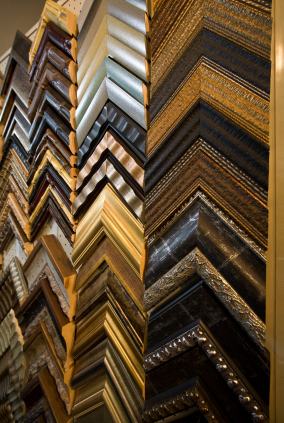Choosing a Frame
A frame does more than just offer structural support to a work of art. A frame creates a transition from a three-dimensional decorative world into a two-dimensional imaginary one. It provides a buffer zone that separates the artwork while giving it a proper decorative context within a room.
The Frame Factory has literally hundreds of different wood, styles, colors, and finished to choose from. We understand that the selection of just the right frame can be a daunting task; however, our trained framers have the experience to help you make the perfect pick. Below are a few tips that will help you select the perfect picture frame.
Match Your Style
When selecting a frame, choose one that either complements the style of the art or look to the decor of the room where it will be displayed.
- Traditional decor is more formal in tone, and generally looks best with ornate, decorative, gold and silver frames, as well as woods like mahogany and walnut. Traditional decor also includes English Country style, with its wood furnishings and floral accessories.
- Country/Rustic decor is more casual; wooden frames are preferred, especially distressed, weathered, cracked, or untreated wood. Related decor styles include Italian Country and Shabby Chic.
- Contemporary decor is more streamlined, so simple frames look best. Black is a perennial favorite, but other solid color frames are also popular.
- Casual/Eclectic decor is a wide open style with a free-spirit quality. Frames with strong personalities are common. Light-colored frames are popular.
Frame Size
The thickness of the frame can be one of the most important decisions in the selection process. Incorrectly sized framing will not enhance the art but distract from it. Although there are no absolute rules, these should help you through the selection process.
- Generally speaking, use a wide frame on large art and a thin frame on small art. A wide frame adds presence and substance to a large piece hanging over a sofa or mantelpiece. A thin frame will not overwhelm smaller works of art.
- Thin frames are especially preferred when multiple images with the same frame are displayed in wall groupings.
- A thin to medium-width frame tends to thrust the image forward. This is often preferred for museum classics that shouldn't have to compete for attention with a frame.
- Wide frames tend to feel like part of the artwork itself, and are often used as a decorative accent for contemporary images.
Frame Color
Matching your frame to a color in the art is not as important as matching the frame to your room decor. In fact, it's easy to overdo it when it comes to matching color. Keep in mind the overall color tone of the image, rather than specific colors. Warm tones (red, orange, brown) in the image would generally look better with warm frames such walnut and mahogany and with antique gold frames. Cool tones (blue, green, lavender) look better with light woods, natural woods and brighter gold frames.
- As a general rule, choose lighter colored frames for art that is light, simple or casual, such as you'll find in rustic art or botanical prints.
- Choose dark frames for a more stable, elegant, formal look with museum classics. A thin dark frame can be used with lighter prints because it doesn't feel very heavy.
- Gold frames are very flexible and match a wide variety of art styles. Most modern and abstract art looks good with black frames, while Impressionist art is seldom framed in black.
- When choosing a frame color, be careful that the frame color isn't too similar to the wall color or the frame will disappear into the wall.
- Generally, the frame color should be different from the mat color. Similarly colored frames and mats draw attention to themselves, and away from the image.
Match a Framed Print You Already Own
It may not be possible to find an exact match for a frame you already own. An exact duplicate isn't necessary to create a harmonious set, and many designers avoid exact matches on principle. However, you should try to match the basic style and color. For example, a medium-width gold frame with a rope design will match a medium-width gold frame with a floral or beaded design. Matching color alone, and ignoring size, can be beautiful. For example, match a wide, glossy black frame with a medium-width glossy black frame. On the other hand, intentionally mismatching frames is a fundamental rule in eclectic decor style.

